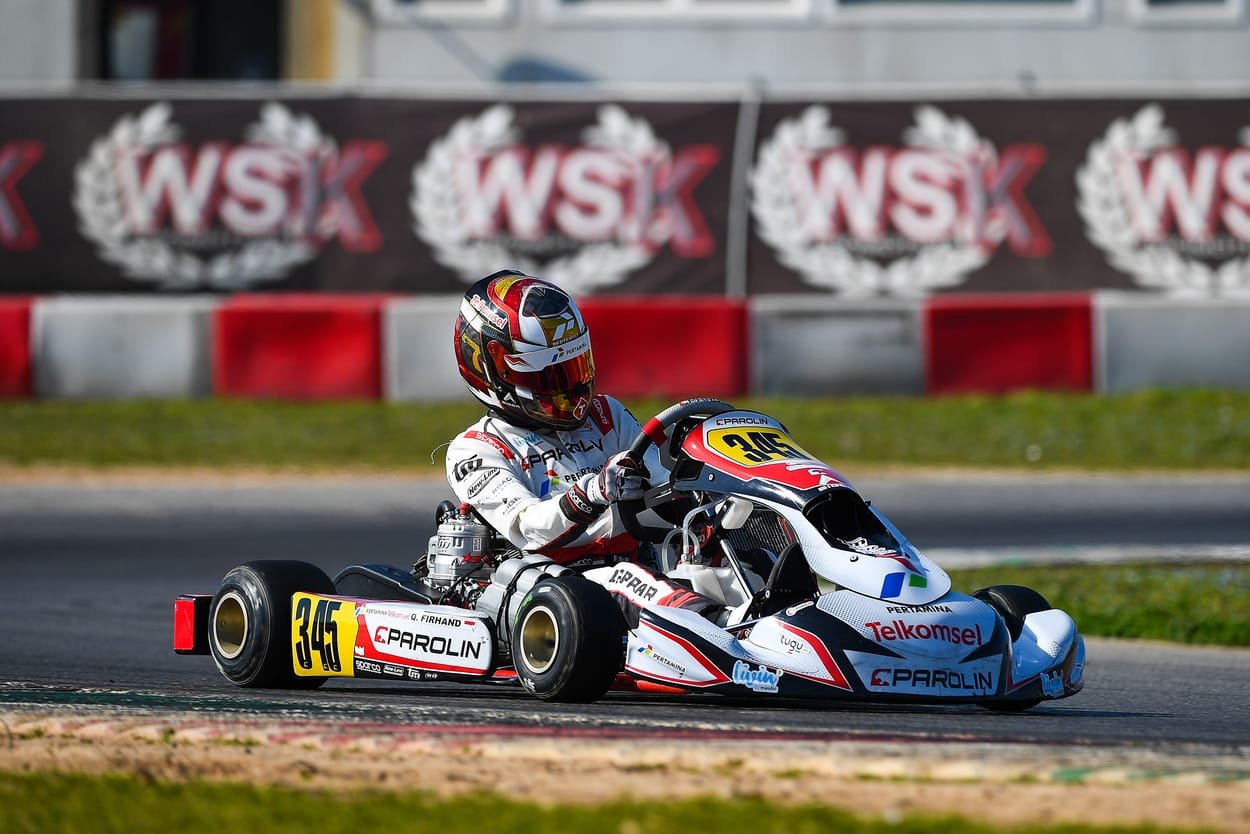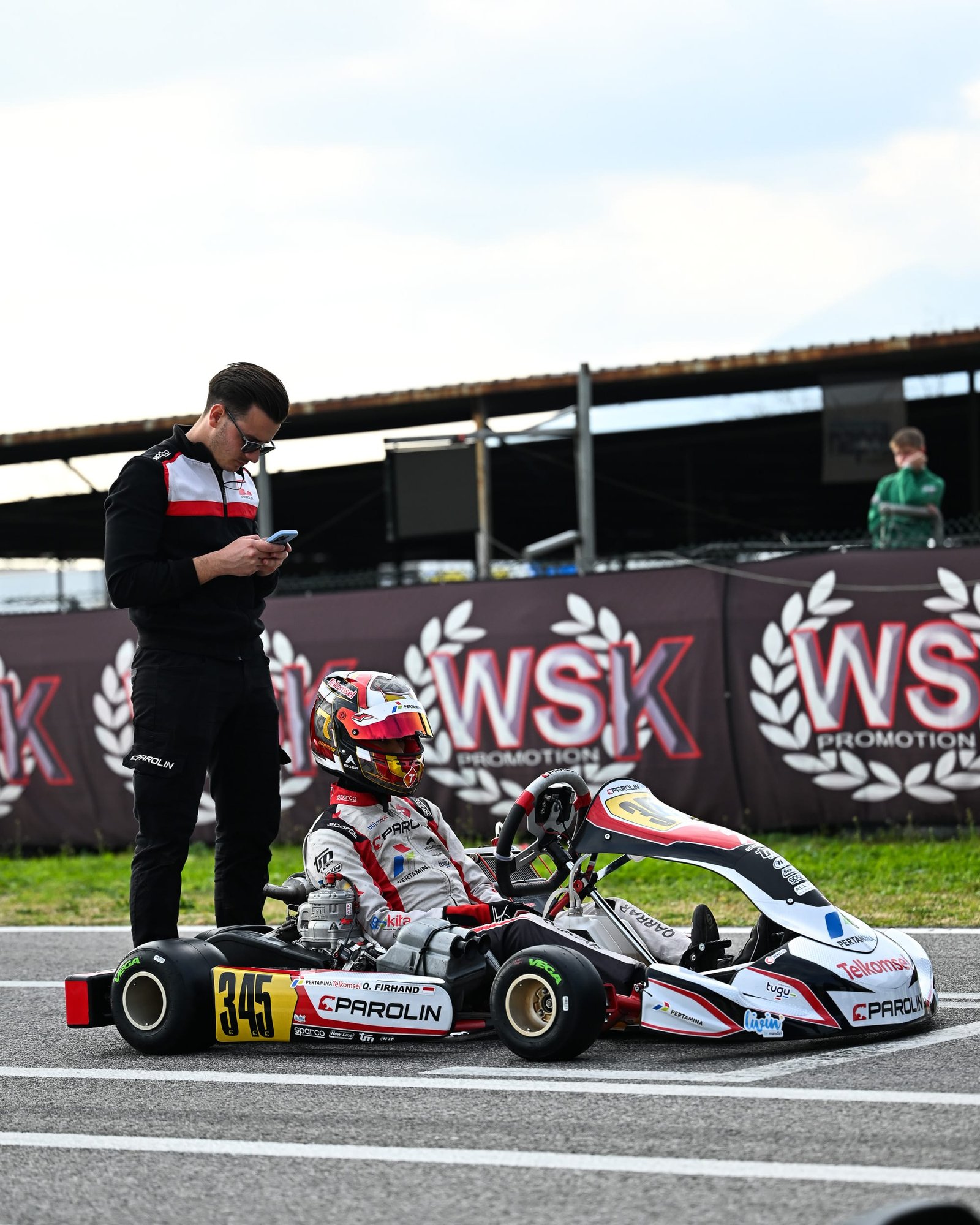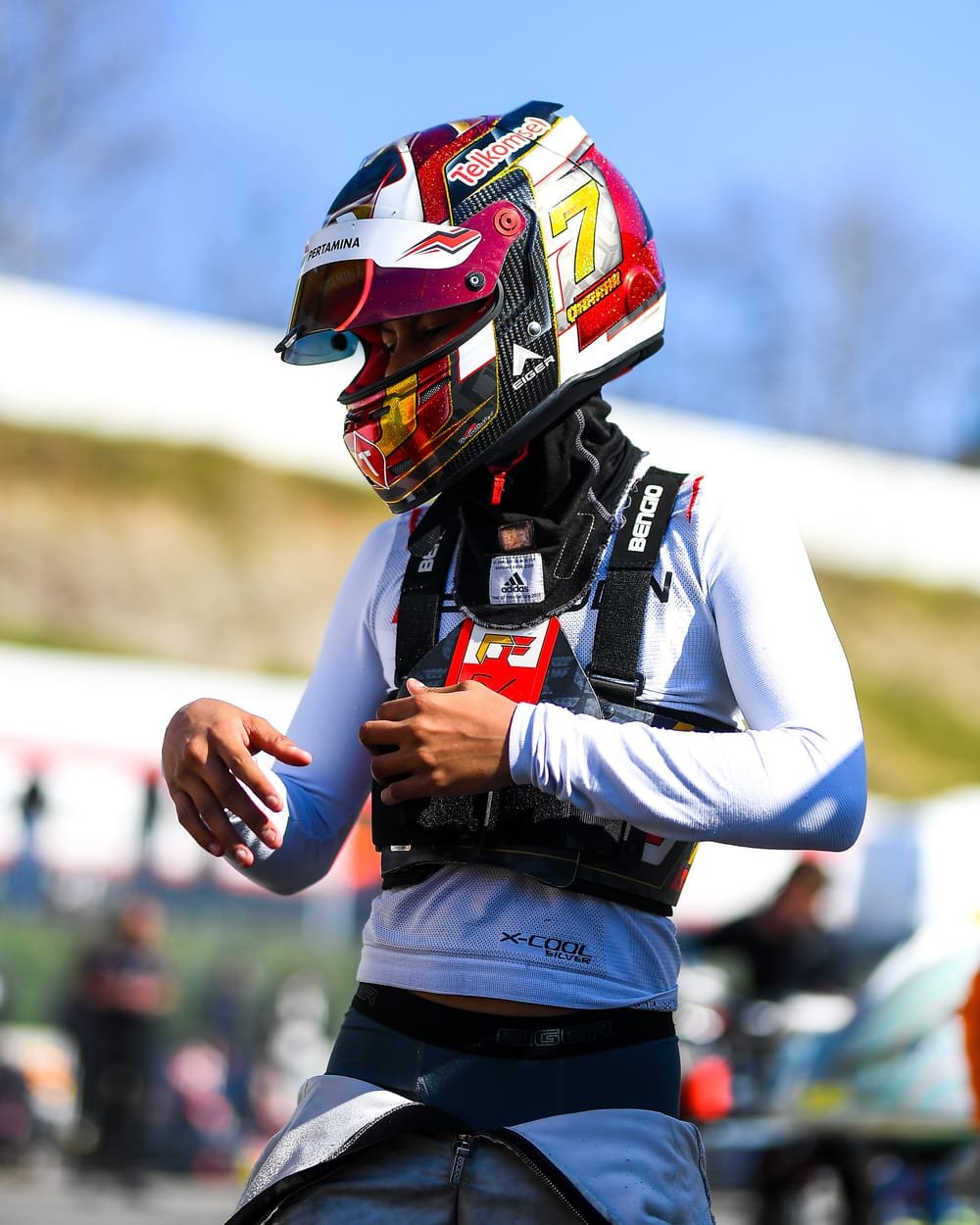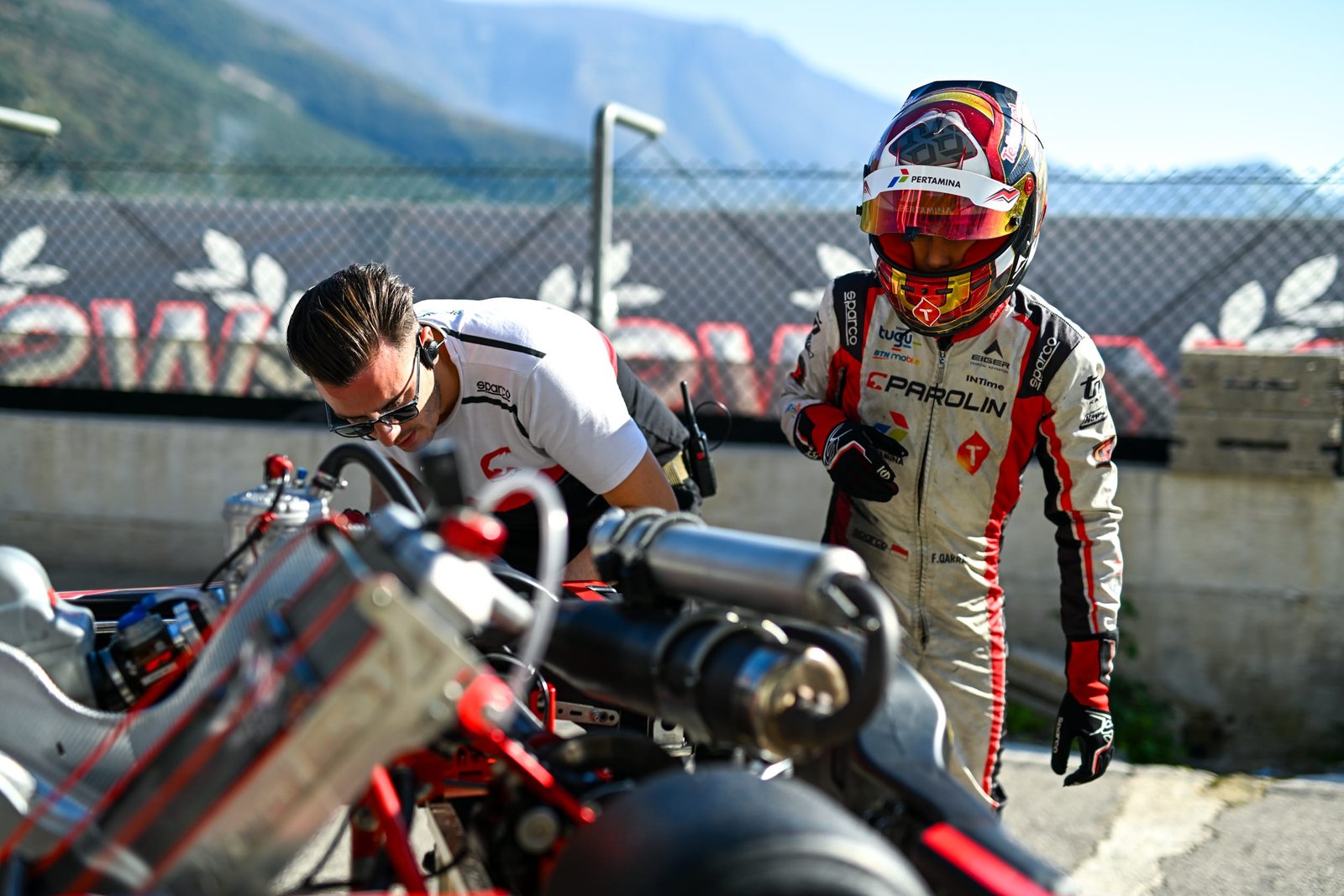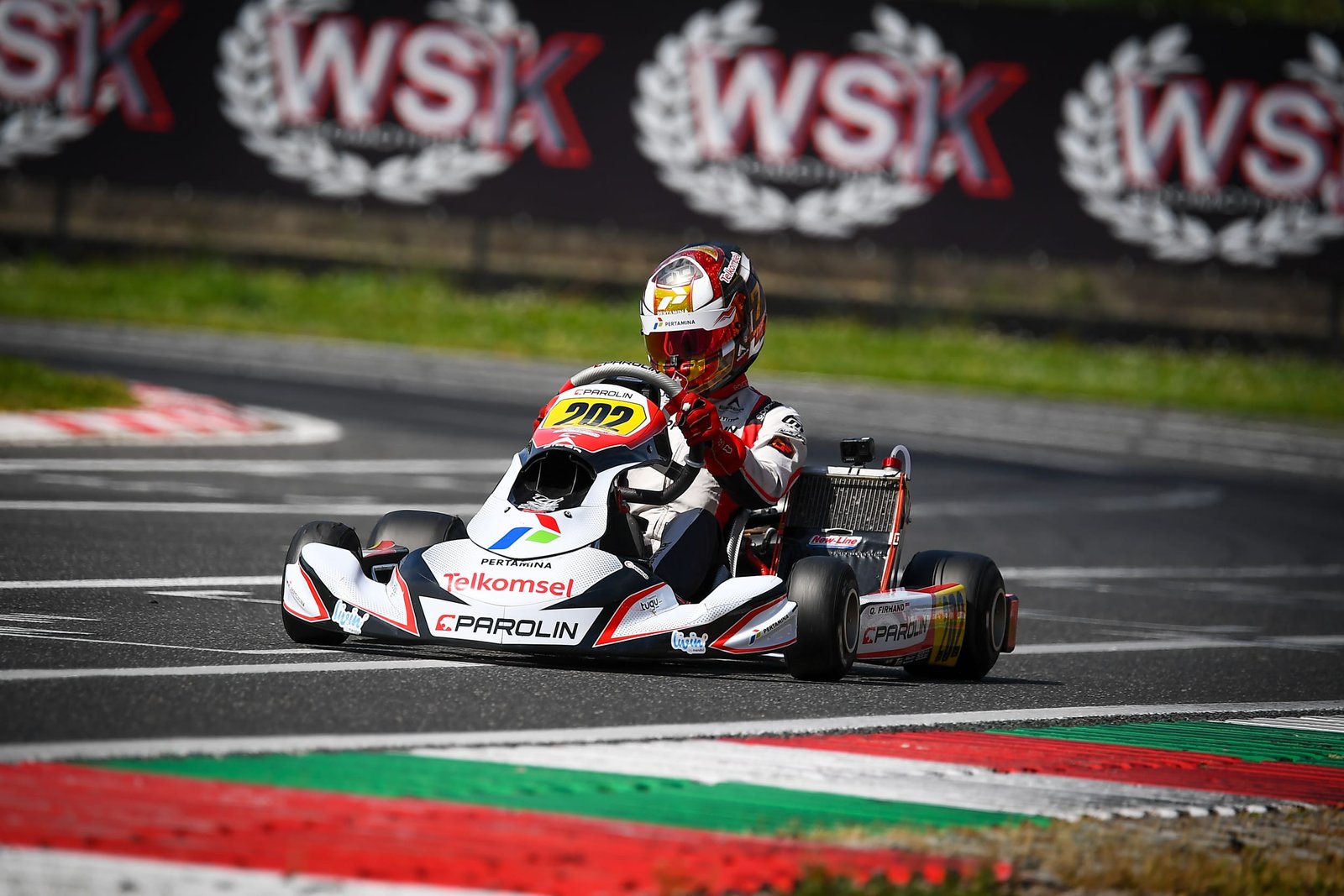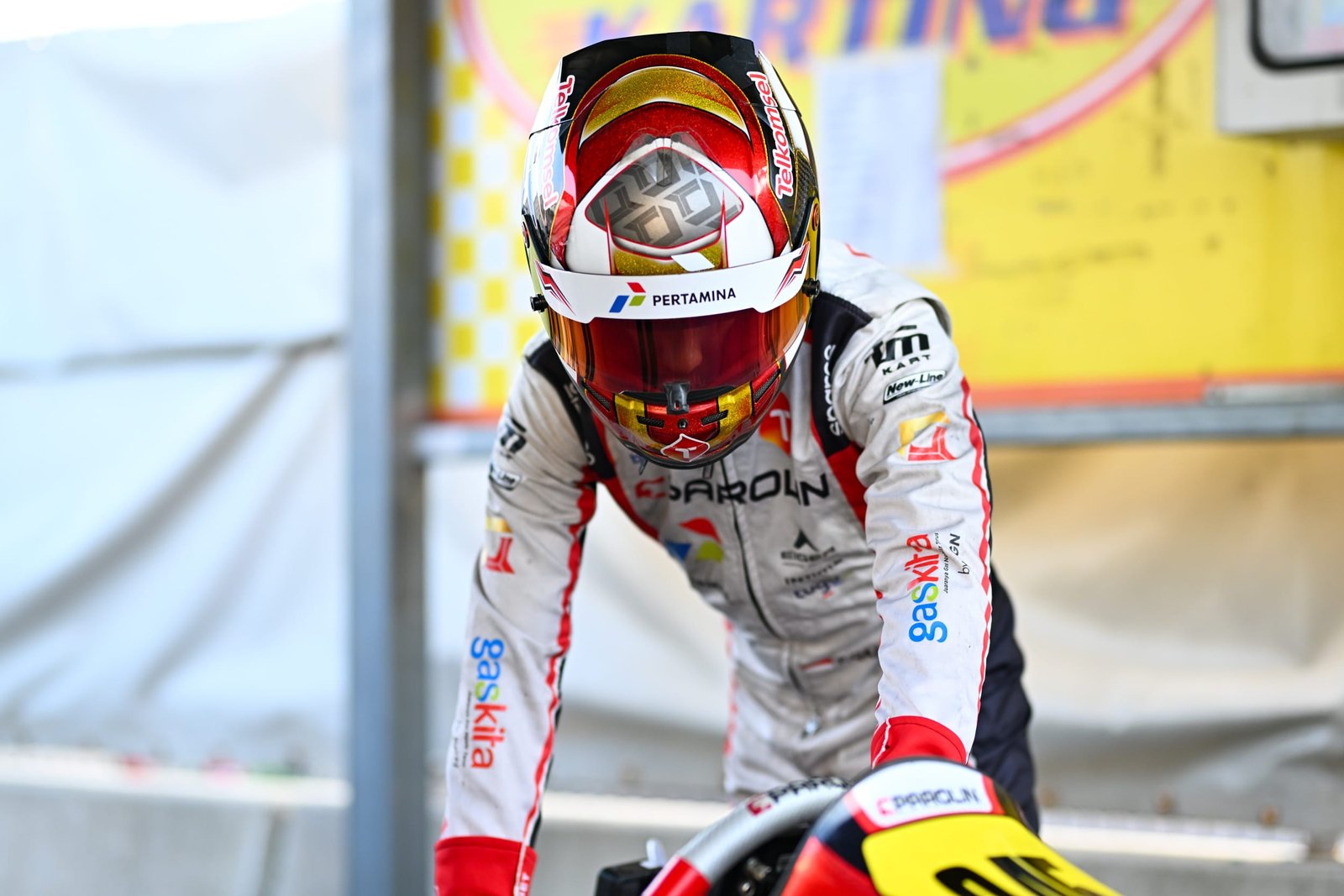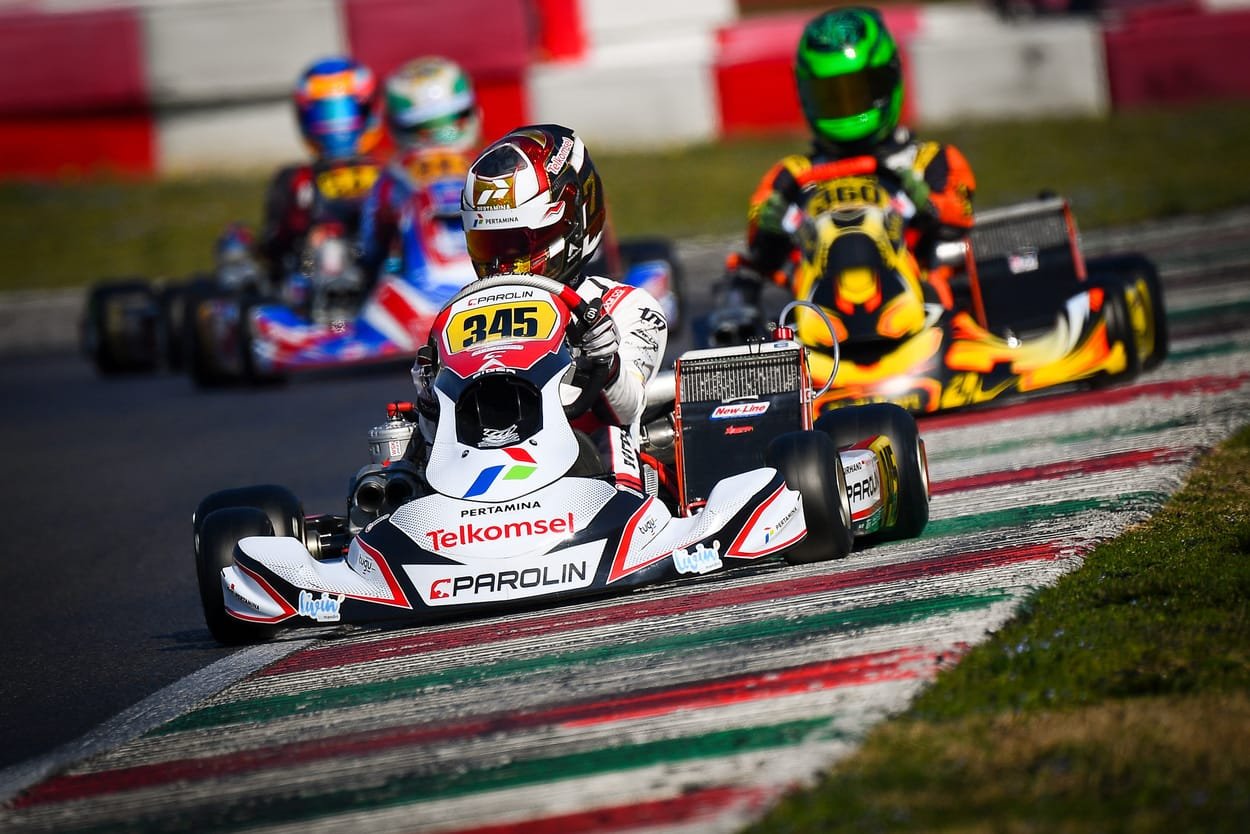At just 13 years old, Qarrar has already left tire marks across continents. Born in Jakarta, he gripped his first steering wheel at five, guided by his father’s passion for speed. Today, he trains at Italy’s South Garda Karting, a proving ground for future champions.
His mornings roar to life with high-speed laps on European circuits. Afternoons shift gears to textbooks at Brescia International School. Juggling podium pursuits and algebra tests demands precision – every second counts. “You learn to plan like a strategist,” he says, mastering split-second decisions on and off the track.
The young driver’s journey from local races to global competitions mirrors his grit. Jakarta’s humid tracks forged his reflexes, while Italy’s technical courses sharpened his racecraft. Behind the helmet lies a student determined to excel, fueled by Indonesia’s hopes and his own sky-high goals.
Family backing and coaching teams form his pit crew against daily challenges. Their encouragement fuels late-night study sessions after grueling practices. This synergy between mentorship and self-discipline keeps his twin engines – racing and learning – firing in unison.
Qarrar’s story isn’t just about crossing finish lines. It’s a blueprint for aspiring champions worldwide, proving that with smart planning and relentless drive, no corner is too sharp to navigate.
Charting Qarrar’s Journey in Motorsport
From Jakarta’s local tracks to global podiums, Qarrar accelerates past competitors. His trophy cabinet gleams with wins at the WSK Super Master Series and FIA Karting World Championship. Each victory showcases his explosive growth – climbing from 14th to 3rd place in just two seasons.
What fuels this relentless success? A razor-sharp approach blending mental drills with technical precision. Qarrar spends hours analyzing race telemetry, adjusting braking points by centimeters. “Racing isn’t just speed – it’s solving puzzles at 60 mph,” he explains.
Key skills separate him from the pack:
- Adaptive driving: Mastering wet and dry conditions equally
- Racecraft: Overtaking strategies honed through simulator marathons
- Equipment optimization: Tweaking gear ratios mid-event for maximum performance
His training revolutionizes traditional methods. Virtual reality sessions prep for unfamiliar circuits, while neurofeedback headsets track focus levels. Coaches marvel at his 0.3-second lap improvements through microscopic adjustments.
This dynamic approach keeps rivals in his dust. When rain drenched the Adria International Raceway last season, Qarrar’s weather-reading skills secured a podium finish. Fans now recognize his signature move – late-braking dives that rewrite race dynamics.
Every championship point reflects his philosophy: Performance peaks when preparation meets passion. As Qarrar guns for higher karting categories, his journey redefines what’s possible for teen racers worldwide.
Foundations: Early Karting and Academic Beginnings
Champions aren’t built in straight lines—they’re forged through sharp turns and steady acceleration. Before podiums and textbooks, there were scraped knees and multiplication tables. This dual grind shaped a prodigy’s blueprint.
First Steps Behind the Wheel in Jakarta
A miniature helmet wobbled above the steering wheel as five-year-old Qarrar tackled his neighborhood track. Jakarta’s sweltering heat baked the asphalt, but the future star kept circling. “I crashed more times than I finished,” he laughs, recalling those raw beginnings. Weekends became laboratories for mastering throttle control and tire grip.
Key milestones marked his rise:
- Mastering wet-track drifts at seven
- Securing first regional trophy by age nine
- Analyzing race footage during school lunches
Building a Discipline in Education
Classrooms proved equally demanding. Brescia International School’s structured schedule turned into his secret weapon. Teachers adapted lessons around race calendars, while study sessions replaced playground breaks. Math transformed into aerodynamics practice; history essays doubled as focus drills.
His daily rhythm became legendary:
- 5:30 AM: Physics problems over breakfast
- 3:00 PM: Debriefing lap times with coaches
- 8:00 PM: Language studies between simulator runs
This relentless cadence birthed an unstoppable pattern—every academic challenge strengthened his track focus, each racing setback taught classroom resilience. Young athletes worldwide now study this blueprint, where grit gets polished like championship trophies.
The Bold Shift: Transitioning to European Racing
Stepping onto European soil marked more than a career move—it became a crucible of transformation. At 12, the Indonesian phenom traded Jakarta’s humid circuits for Italy’s razor-edged tracks. South Garda Karting’s facilities offered cutting-edge technology, but demanded total reinvention.
Adapting to New Tracks and Cultures
Language barriers hit first. Menus became puzzles, race briefings a crash course in Italian. “I learned ‘accelerazione’ before ‘buongiorno’,” he grins. Technical challenges followed—European tracks punished mistakes Jakarta forgave. Corners tightened like coiled springs, demanding millimeter-perfect lines.
| Challenge | Jakarta | Italy |
|---|---|---|
| Track Complexity | 6-8 turns | 12-15 turns |
| Cultural Environment | Familiar dialect | Multilingual teams |
| Training Intensity | 3 hrs/day | 6 hrs/day |
Coaches became cultural translators and technical gurus. Marco Rossi, his lead trainer, redesigned programs weekly. “We rebuilt his driving DNA,” Rossi states. Morning neuro-training sessions sharpened reaction times, while afternoons drilled weather-adaptive techniques.
Team support eased the stress of constant adaptation. Nutritionists balanced nasi goreng cravings with pasta fuel. Mechanics tweaked karts for rain-slicked Lombardy circuits while tutors bridged classroom gaps. This ecosystem turned culture shock into competitive edge.
The shift forged unexpected strengths. Navigating Brescia’s cobblestone streets improved spatial awareness. Language mishaps taught quick thinking under pressure—skills that later saved races. “Every stumble became stepstones,” he reflects, eyes on higher championships.
Balancing Education and Racing: Qarrar’s Dual Life
Success at 100 mph and in calculus class doesn’t happen by accident. The young racer’s days explode into action at dawn – physics formulas before breakfast, tire pressure checks by noon. “You either control the clock, or it controls you,” he states, reviewing homework between simulator runs.
Academic deadlines clash with race prep in constant tests of focus. History exams demand memorization; wet tracks require instinct. Coaches developed a color-coded schedule mapping study blocks against track time. Non-negotiable slots protect both realms:
- 90-minute evening reviews of race telemetry
- Morning language drills during warm-up laps
- Weekend simulations synced with project due dates
Travel becomes mobile classrooms. Flight hours transform into essay-writing marathons; hotel stays host video calls with tutors. “Every minute has purpose,” explains his math teacher, noting completed assignments from five time zones.
This military-grade organization fuels dual breakthroughs. Recent podium finishes coincided with top science fair rankings. The system proves balance isn’t splitting hours equally – it’s aligning effort with ever-shifting priorities.
“Champions don’t choose between books and engines,” the prodigy asserts. His blueprint reveals truth: Excellence anywhere starts with mastering time everywhere.
The Power of Mental Preparation in High-Speed Racing
Championship trophies are won in the mind before the engine starts. For young competitors like Qarrar, mental discipline becomes the ultimate performance enhancer. This invisible edge transforms pressure into fuel – both on Lombardy’s rain-slicked tracks and during timed algebra quizzes.
Visualization Techniques for Pre-Race Confidence
Each race morning begins behind closed eyelids. Qarrar mentally rehearses every turn of circuits like Adria International Raceway. “I see braking markers, feel g-forces, even smell burning rubber,” he shares. This ritual helped secure his 2023 FIA Karting World Championship position through precise overtaking simulations.
| Mental Drill | Race Application | School Benefit |
|---|---|---|
| 5-minute breathwork | Steadies heart rate pre-start | Calms exam nerves |
| VR circuit walkthroughs | Identifies wet-track escape routes | Visualizes complex math solutions |
| Positive affirmation loops | Boosts passing confidence | Strengthens presentation skills |
Stress Management and Neuro-Training Drills
When a 2022 wall collision dented his season, Qarrar rebuilt through neurofeedback sessions. Sensors tracked brainwaves during simulator runs, optimizing focus under stress. Coaches report 40% faster recovery times after setbacks.
School pressures feed this resilience. Missed lectures during competitions? He attacks makeup work with race-day intensity. “Both worlds teach comeback strategies,” notes his physics tutor. Nightly meditation sessions now anchor his schedule, blending karting focus with academic clarity.
This mental toolkit proves powerful beyond stopwatches. As Qarrar eyes higher categories, his greatest asset isn’t horsepower – it’s the disciplined mind steering it.
Technical Mastery: From Precision Driving to Equipment Optimization
In the high-stakes world of competitive karting, every millimeter and millisecond counts. Racers thrive by merging mechanical savvy with split-second instincts. One young competitor’s approach redefines technical excellence through relentless refinement.
The Late Braking Revolution
Verstappen-inspired tactics fuel dramatic overtakes. By delaying braking zones by 0.2 seconds, drivers gain crucial passing opportunities. This high-risk strategy demands:
- Muscle memory forged through 500+ simulator hours
- Real-time track temperature analysis
- Precision clutch adjustments mid-corner
| Technique | Monsoon Cup Application | Outcome |
|---|---|---|
| Dynamic gear ratios | 3rd-gear starts on wet asphalt | 0.8s faster launches |
| Brake bias tuning | 65% rear bias in heavy rain | Improved hydroplaning control |
| Tire camber shifts | +0.5° adjustment for drying tracks | Enhanced cornering grip |
Last season’s monsoon showdown proved these strategies. Slick conditions erased visibility, but calculated setup changes delivered a podium finish. “You adapt or crash,” the driver recalls, detailing last-lap suspension tweaks that secured third place.
Continuous improvement drives this technical philosophy. Nightly data reviews spot micro-improvements – 0.1° steering adjustments or 50ms throttle response gains. Coaches report 12% faster lap times through these incremental changes.
Such mastery builds resilience against ever-changing circuits. As categories advance, these honed skills become the foundation for future domination. The lesson? Champions aren’t born – they’re engineered.
The Daily Regimen: Managing Training and Academic Commitments
Dawn breaks as alarms buzz across continents – but one athlete’s morning ritual outpaces them all. By 5:00 AM, the young racer’s feet hit the floor, launching a 16-hour marathon where textbooks and throttle controls share equal importance. This precision-crafted routine powers both classroom success and podium finishes.
Structured Physical Conditioning and Simulator Sessions
Morning light reveals a kinetic ballet of discipline. Cardio blasts kickstart metabolism, while resistance training builds neck muscles for high-G corners. Post-workout simulator runs replicate Monza’s chicanes and Spa’s elevation changes, sharpening split-second decisions. Coaches track progress through measurable gains:
| Training Element | Duration | Performance Impact |
|---|---|---|
| High-intensity intervals | 45 mins | +12% endurance |
| VR race simulations | 90 mins | 0.4s faster laps |
| Hydration drills | 20 mins | Improved focus |
“Simulators teach resilience,” notes his trainer. “Mistakes here cost pixels, not championships.”
Effective Use of Time Management in Studies
Academic rigor meets racing intelligence during afternoon sessions. Physics formulas map aerodynamic principles, while math equations optimize gear ratios. Strategic scheduling turns downtime into growth opportunities:
- Post-training cool-downs: Language podcasts through sweat-drenched headphones
- Lunch breaks: Flashcard reviews between bites
- Travel transitions: Essay drafting at 30,000 feet
Over years, this symbiotic system elevated both GP rankings and GPA scores. The routine’s importance shines brightest under pressure – when exams collide with qualifying rounds, preparation conquers chaos.
Future champions study this blueprint: Where others see conflicting priorities, true contenders find synergy. Every mastered minute propels the journey from local tracks to world stages.
Resilience in Action: Overcoming Setbacks on and off the Track
Champions don’t dodge obstacles—they launch over them. For this young racer, every skid mark tells a story of comeback strategies. The 2022 season proved pivotal when a high-speed wall collision left his kart—and confidence—in pieces.
Learning from Crashes and Adjusting Strategies
That crash became a masterclass in adaptation. Telemetry revealed overambitious braking points, prompting millimeter adjustments to his approach. “Mistakes are free lessons,” he states, now using that incident as a teaching example for junior drivers.
Classroom challenges mirrored track struggles. A missed exam during the European Championship forced innovative solutions—recording lectures during warm-up laps. These experiences created unexpected growth opportunities:
- Physics projects analyzing crash forces improved suspension setups
- Language barriers during recovery sparked accelerated learning techniques
- Structured revision schedules now mirror race-week preparation rituals
This mindset transforms setbacks into competitive advantages. After struggling with wet-track starts, he devised a tire-warming drill using math equations timed to pit-stop rhythms. Coaches report 22% faster reaction times since implementation.
The synergy between academics and racing fuels continuous improvement. Nightly data reviews double as focus exercises, while complex circuits inspire creative problem-solving in STEM projects. Each challenge conquered off-track strengthens on-track precision.
His journey stands as living proof: True excellence emerges not from avoiding falls, but from perfecting the art of rising faster. For aspiring champions, that’s the ultimate growth blueprint.
Transitioning Between Karting Categories: New Demands, New Skills
Gear shifts define racing careers—especially when changing categories. Moving from Mini to Junior karting introduces fiercer battles and technical extremes. Speeds jump from 60 mph to 75 mph, while cornering forces demand neck strength rivaling professional athletes. This leap separates hopefuls from contenders.
From Mini to Junior: Navigating Increased Competition
Junior competitions test more than speed—they challenge adaptability. Wider grids pack 34 drivers instead of 24, shrinking overtaking windows. Qarrar recalibrated his approach through intense simulator work, studying rivals’ braking patterns frame-by-frame. “You need new eyes for every race,” he states, analyzing telemetry until midnight.
| Aspect | Mini Karting | Junior Category |
|---|---|---|
| Top Speed | 60 mph | 75 mph |
| Physical Demand | 2.5G forces | 3.8G forces |
| Race Duration | 12-15 laps | 18-20 laps |
Training schedules transformed overnight. Morning workouts now include neck harness drills and grip-strength circuits. Track sessions focus on tire management—preserving rubber through strategic coasting. Coaches redesigned programs to mirror the relentless pace of championship-level activity.
Every weekend race becomes a masterclass. Recent events taught Qarrar to predict opponents’ moves by their body positioning mid-corner. Team debriefs dissect micro-mistakes, from delayed shifts to millimeter-wide racing lines. This meticulous work ethic turns each checkpoint into stepping stones toward podium finishes.
“Change fuels growth,” the young driver asserts, embracing tougher rivals and faster machines. His journey proves categories don’t limit potential—they reveal it.
Global Competition: Embracing Cultural Differences and Diverse Techniques
Racetracks transform into cultural laboratories where speed meets tradition. Competing across three continents reveals distinct racing philosophies – Japanese precision contrasts Italian aggression, while Scandinavian drivers master icy control. This global classroom sharpens adaptability, turning every grid position into a masterclass.
Analyzing International Driving Styles
Opponents’ techniques become living textbooks. Qarrar studies French competitors’ late apexes and British racers’ defensive lines through shared telemetry sessions. Communication bridges gaps during paddock debriefs, where rivals exchange setup secrets over espresso.
| Region | Signature Move | Adaptation Strategy |
|---|---|---|
| Germany | Early throttle application | Adjust brake bias -5% |
| Brazil | Aggressive kerb-riding | Reinforce chassis mounts |
| Japan | Minimal steering inputs | Increase front tire pressure |
Category leaders provide unexpected help through post-race insights. “We’re all chasing milliseconds,” notes a Dutch competitor. These exchanges fuel technical evolution across borders.
Carrying National Pride on the Global Stage
Indonesia’s red-and-white flag flies bold above European podiums. Setbacks like monsoon delays at Sepang taught resilience – now monsoons trigger calculated risks instead of hesitation. Support crews amplify this momentum, translating Bahasa pep talks into pit-wall strategies.
Every checkered flag waves double victory: personal achievement and national representation. Young fans flood social media with homemade kart designs, their messages clear – “Kami bangga!” (We’re proud!). This energy propels late-night simulator marathons when jet lag strikes.
The racing world thrives on shared passion. Cultural exchanges don’t dilute identity – they forge stronger champions. As boundaries blur between nations, tracks remain spaces where unity outpaces rivalry.
Final Reflections: The Dual Journey of Growth and Excellence
Tire smoke fades, but legacies accelerate. This young champion’s path reveals careers aren’t built alone—they’re fueled by grit, guidance, and gritted-teeth comebacks. Every podium photo hides late-night study sessions; each academic award echoes screeching tires on distant tracks.
Critical lessons emerge from both worlds. Missed apexes taught precision focus applicable to exams. Failed experiments inspired creative race strategies. “Victories belong to those who prepare—and those who help you prepare,” he notes, nodding to coaches and tutors.
Robust support networks prove non-negotiable. Mechanics double as physics tutors, while language teachers decode foreign briefings. This ecosystem transforms isolated efforts into collective triumphs.
Future champions take note: Excellence demands evolution. Careers thrive through constant learning—whether decoding wet-track grip coefficients or mastering Mandarin verbs. Progress lives in the pivot between challenges.
The checkered flag waves ahead, but the real win lies in the journey. For dreamers worldwide: Rev your engines, open your books, and surround yourself with those who believe faster than you doubt.

